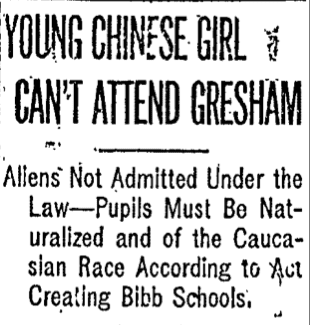End date 1927 | ||
 | ||
Full case name Gong Lum, et al. v. Rice et al. Citations 275 U.S. 78 (more)
48 S. Ct. 91; 72 L. Ed. 172 Prior history Trial court ordered writ of mandamus. Reversed by Supreme Court of Mississippi, 139 Miss. 760, 104 So. 105. Subsequent history Affirmed, 139 Miss. 760. Majority Taft, joined by unanimous Ruling court Supreme Court of the United States Similar Sipuel v Board of Regents, McLaurin v Oklahoma State Reg, Pace v Alabama, Perez v Sharp, Elk v Wilkins | ||
Gong lum v rice
Lum v. Rice, 275 U.S. 78 (1927), is a United States Supreme Court case in which the Court held that the exclusion on account of race of a child of Chinese ancestry from a state high school did not violate the Fourteenth Amendment to the United States Constitution. The decision effectively approved the exclusion of minority children from schools reserved for whites.
Contents
Background
In 1924, a nine-year-old Chinese-American named Martha Lum, daughter of Gong Lum, was prohibited from attending the Rosedale Consolidated High School in Bolivar County, Mississippi solely because she was of Chinese descent. There was no school in the district maintained for Chinese students, and she was forced by compulsory attendance laws to attend school.
A lower court granted the plaintiff's request of a writ of mandamus to force the members of the Board of Trustees to admit Martha Lum. Gong Lum's case was not that racial discrimination as such was illegal but that his daughter, being Chinese, had incorrectly been classified as colored by the authorities.
Since the ruling went against them, the Board of Trustees became the plaintiff, and Lum was named the defendant in the case Rice v. Gong Lum, which was heard in the Supreme Court of Mississippi. The Mississippi Supreme Court reversed the lower court's decision and allowed the Board of Trustees to exclude Martha Lum from the school for white children. Gong Lum appealed the state Supreme Court's ruling to the US Supreme Court.
The Supreme Court's decision
In an opinion written by Chief Justice William Howard Taft, the US Supreme Court affirmed the Mississippi supreme court's ruling and thus the position of the Board of Trustees. In the unanimous opinion, Taft held that the petitioner had not shown that there were no segregated schools accessible for the education of Martha Lum in Mississippi:
"We must assume, then, that there are school districts for colored children in Bolivar county, but that no colored school is within the limits of the Rosedale consolidated high school district. This is not inconsistent with there being at a place outside of that district and in a different district, a colored school which the plaintiff Martha Lum may conveniently attend."Taft further stated that given the accessibility of segregated schools, the question then was whether a person of Chinese ancestry, born in and a citizen of the United States, was denied equal protection of the law by being given the opportunity to attend a school that received "only children of the brown, yellow or black races." In reference to Cumming v. Richmond County Board of Education, Taft concluded that the "right and power of the state to regulate the method of providing for the education of its youth at public expense is clear." Additionally, Taft pointed to a number of federal and state court decisions, most prominently Plessy v. Ferguson, all of which had upheld segregation in the public sphere and particularly in the realm of public education. Accordingly, Taft concluded:
The judgement of the Mississippi Supreme Court was affirmed. Martha Lum was not allowed to go to the school for white children.
Subsequent developments
Lum was effectively overruled by the Court's decision in Brown v. Board of Education (1954), which outlawed segregation in public schools.
